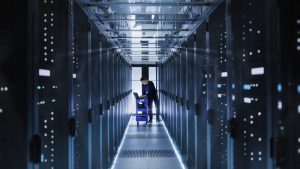Over the last several years, the move to the cloud has stabilized as the applications that could be easily and cost effectively outsourced, were moved to the cloud. The applications left on premise are simply too integrated into local operations or too expensive to move. This forced a change to the way data center staffs manage their assets with some assets outsourced and others still on-premise/at “the edge”.
The new “hybrid” data centers architecture can consist of a combination of – a centralized cloud characterized by massive compute and storage, regional edge data centers that consist of large compute and storage located closer to the user, and local edge with smaller compute and storage assets very near to where the data is being consumed like a branch office or retail store. According to recent data gathered by 451 Research analysts, by year 2019 organizations anticipate that just under half (46%) of enterprise workloads will run in on-premise IT environments, with the remainder off-premise.
Defining characteristics of a hybrid data center environment
A number of hybrid data center characteristics are beginning to emerge that diverge from well-worn traditional approaches:
- Application suitability – Legacy applications are typically unsuited to run off-premise, which is driving more enterprises to modernize existing workloads wherever possible and develop net new applications built for the cloud.
- Workload management – Workloads are analyzed on a case-by-case basis. Risk, cost and IT service performance are the variables that determine which of different data center environments prove most efficient for the particular workload.
- Advanced software tools – Companies managing hybrid environments are investing in software tools that provide greater visibility into each of the three data center iterations.
Specialized tools and techniques can simplify the task of managing hybrid environments. In the case of local edge data centers, for example, micro data centers, are emerging as key approaches that act as enablers of the local edge applications and are ideal for broadband-consuming high bandwidth delivery, latency sensitive applications, and IoT applications involving data gathering and processing.
Yes, micro data centers are slightly different
Micro data centers are self-contained IT infrastructure that are enclosed in one or many hardened, conditioned, secure cabinets. The cooling (hot air removal), as well as power distribution and network connectivity, are built-in. Other integrated functions, such as physical security, fire suppression, shielding against electromagnetic interference, power conditioning and uninterruptible power supply or battery are also provided. Because of their small physical size and fully self-contained functionality, these data center configurations can proliferate as more “things” are internet-connected and can process and store high volumes of data.
Requirements for more advanced software and skills
New Data Center Management as a Service (DMaaS) architectures are necessary to manage the emerging hybrid data center environments. One of these, Schneider Electric’s EcoStruxure IT, delivers visibility and scalability of management systems via a vendor-agnostic, IoT-enabled, open and interoperable system architecture. EcoStruxure IT can connect disparate data centers and IT systems to enable operators to remotely, rapidly, and securely scale management ecosystems while harnessing insights from a proprietary data pool of anonymous global users. This information provides real-time visibility and predictive analytics across the entire hybrid environment.
See what drives our innovation
Learn more about how Schneider Electric data center tools, architectures and products, can help optimize hybrid data center performance.

